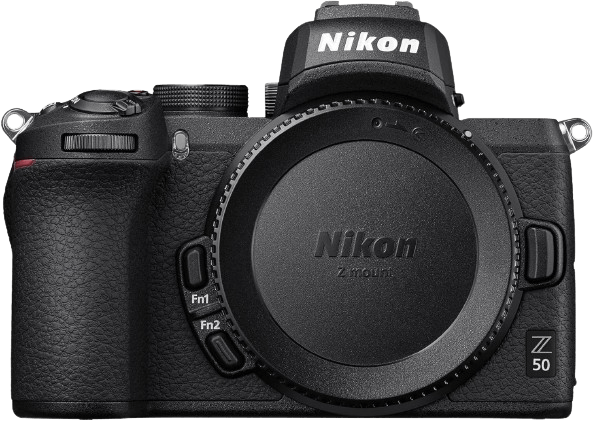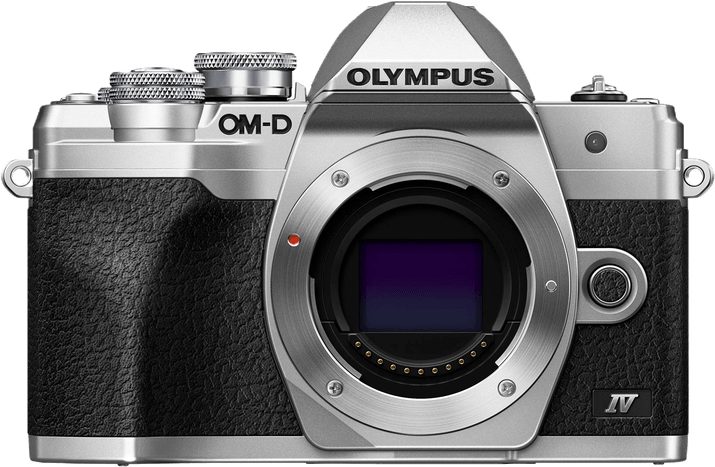Nikon Z50 vs Olympus OM-D E-M10 Mark IV Comparison
Nikon Z50

Olympus OM-D E-M10 Mark IV

The Nikon Z50 outperforms the Olympus OM-D E-M10 Mark IV with a score of 73/100 compared to 63/100. Both cameras share similarities, being mirrorless and released within a year of each other. The Nikon Z50, launched in 2019, is larger and heavier, measuring 127 x 94 x 60mm and weighing 450g. This camera’s superior score is due to its better overall performance and features.
On the other hand, the Olympus OM-D E-M10 Mark IV, released in 2020, has a smaller size of 122 x 84 x 49mm and lighter weight of 383g, making it more portable. It also has a lower launch price of $699 compared to the Nikon Z50’s $859.
Considering each point, the Nikon Z50 is a more advanced camera, but the Olympus OM-D E-M10 Mark IV offers a more affordable and compact option for those prioritizing portability and budget.
Nikon Z50 vs Olympus OM-D E-M10 Mark IV Overview and Optics
The Nikon Z50 outperforms the Olympus OM-D E-M10 Mark IV in optics, scoring 72/100 compared to the Olympus’ 63/100. Both cameras share some common specifications, such as having a CMOS sensor and a similar megapixel count (21 for the Nikon Z50 and 20 for the Olympus OM-D E-M10 Mark IV). Additionally, both cameras have fast shooting speeds, with the Nikon Z50 at 11 fps and the Olympus at 15 fps.
The Nikon Z50 excels due to its superior sensor performance, with a DXOMARK score of 97 compared to the Olympus’ 73. This difference leads to better image quality and low-light performance. The Nikon Z50 also has a larger sensor size (APS-C) than the Olympus (Micro Four Thirds), which contributes to the higher image quality. The Nikon Z50 uses the Nikon Z lens mount, which offers a growing range of high-quality lenses.
On the other hand, the Olympus OM-D E-M10 Mark IV has the advantage of in-body image stabilization, which the Nikon Z50 lacks. This feature can help reduce camera shake and produce sharper images, particularly in low-light situations or when using longer focal lengths. The Olympus also has a 4:3 aspect ratio, which may be preferred by some photographers for certain types of photography, such as portraits.
To conclude, the Nikon Z50 offers better optics performance due to its higher DXOMARK score, larger sensor size, and expanding lens options. The Olympus OM-D E-M10 Mark IV, however, does provide image stabilization and a different aspect ratio that may appeal to some photographers. Ultimately, the decision will depend on individual preferences and specific photography needs.
Nikon Z50 vs Olympus OM-D E-M10 Mark IV Video Performance
The Nikon Z50 outperforms the Olympus OM-D E-M10 Mark IV in video capabilities, scoring 91 out of 100 compared to the Olympus’ 83. Both cameras share some common specifications, such as 4K max video resolution, 3840 x 2160 max video dimensions, and built-in time-lapse functionality. However, the Nikon Z50 surpasses the Olympus in certain aspects, making it the superior choice for video capture.
The Nikon Z50 boasts a higher max video frame rate of 120fps, double that of the Olympus OM-D E-M10 Mark IV, which has a max frame rate of 60fps. This advantage allows the Nikon Z50 to capture smoother, more detailed slow-motion footage, resulting in higher quality video output.
On the other hand, the Olympus OM-D E-M10 Mark IV still offers respectable video capabilities. Its 4K resolution, 3840 x 2160 video dimensions, and time-lapse functionality match those of the Nikon Z50. However, its lower frame rate of 60fps makes it less ideal for slow-motion capture compared to the Nikon Z50.
To conclude, the Nikon Z50 is the better choice for video enthusiasts due to its superior frame rate, which allows for higher quality slow-motion footage. While the Olympus OM-D E-M10 Mark IV shares some similar specs with the Nikon Z50, its lower frame rate ultimately places it behind the Nikon Z50 in terms of video performance.
Nikon Z50 vs Olympus OM-D E-M10 Mark IV Features and Benefits
The Nikon Z50 outperforms the Olympus OM-D E-M10 Mark IV in features, scoring 86/100 compared to the Olympus’ 70/100. Both cameras share some common specifications, including a touchscreen, flip screen, WIFI, and Bluetooth connectivity. Neither camera has GPS functionality.
The Nikon Z50 surpasses the Olympus OM-D E-M10 Mark IV in terms of screen size, offering a 3.2-inch screen compared to the Olympus’ 3-inch screen. This larger screen size provides a better viewing experience for users, making it easier to compose and review images. The Nikon Z50’s higher feature score also reflects its overall superior performance in various aspects, such as autofocus, image quality, and build quality.
Despite its lower feature score, the Olympus OM-D E-M10 Mark IV still has some advantages over the Nikon Z50. Both cameras have the same screen resolution of 1,040,000 dots, ensuring a clear and detailed display. Additionally, the Olympus OM-D E-M10 Mark IV is known for its compact and lightweight design, which may appeal to users who prioritize portability and ease of use.
Taking these points into consideration, the Nikon Z50 is the winner in terms of features, with its larger screen size and higher overall performance. However, the Olympus OM-D E-M10 Mark IV remains a viable option for those who value a compact and lightweight design. Ultimately, the choice between these two cameras depends on the user’s specific needs and preferences.
Nikon Z50 vs Olympus OM-D E-M10 Mark IV Storage and Battery
Both the Nikon Z50 and the Olympus OM-D E-M10 Mark IV score identically with a 35/100 in storage and battery. They share some common specifications, such as a single memory card slot and USB charging capabilities. However, there are differences in other aspects of storage and battery.
The Olympus OM-D E-M10 Mark IV has an edge with its compatibility with UHS-II memory cards, which allows for faster data transfer speeds. Additionally, its battery life is slightly longer, offering 360 shots compared to the Nikon Z50’s 320 shots.
On the other hand, the Nikon Z50 uses the EN-EL25 battery type, which may be more accessible for some users, but this advantage is minimal as both cameras have USB charging capabilities.
Considering their similarities and differences, neither camera has a significant advantage in storage and battery. The Olympus OM-D E-M10 Mark IV’s extended battery life and faster memory card compatibility may be beneficial for some users, while the Nikon Z50’s battery type might be more convenient for others. Ultimately, the choice between these two cameras should be based on other factors, as their storage and battery performance are quite similar.
Nikon Z50 vs Olympus OM-D E-M10 Mark IV – Our Verdict
Are you still undecided about which camera is right for you? Have a look at these popular comparisons that feature the Nikon Z50 or the Olympus OM-D E-M10 Mark IV:

